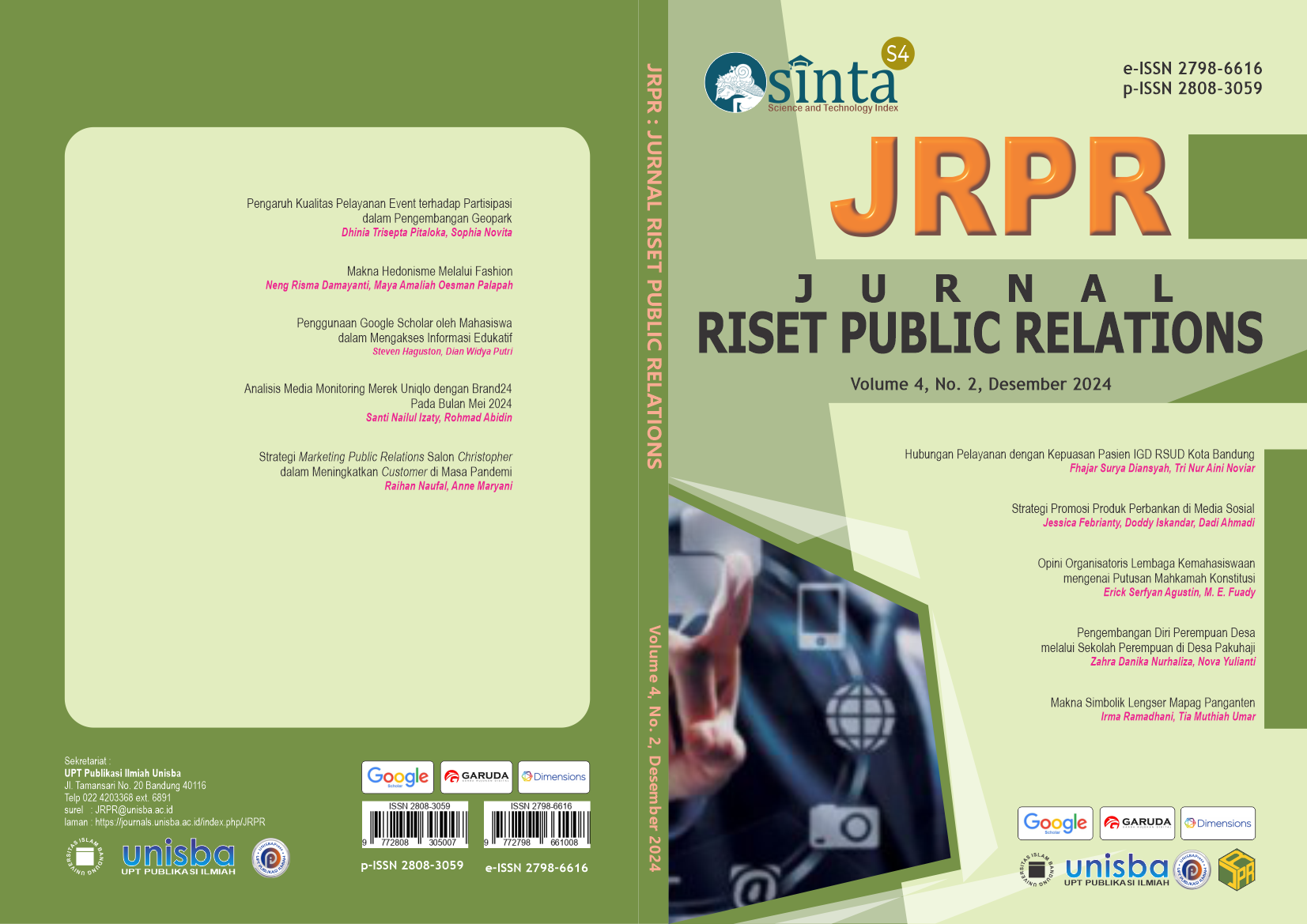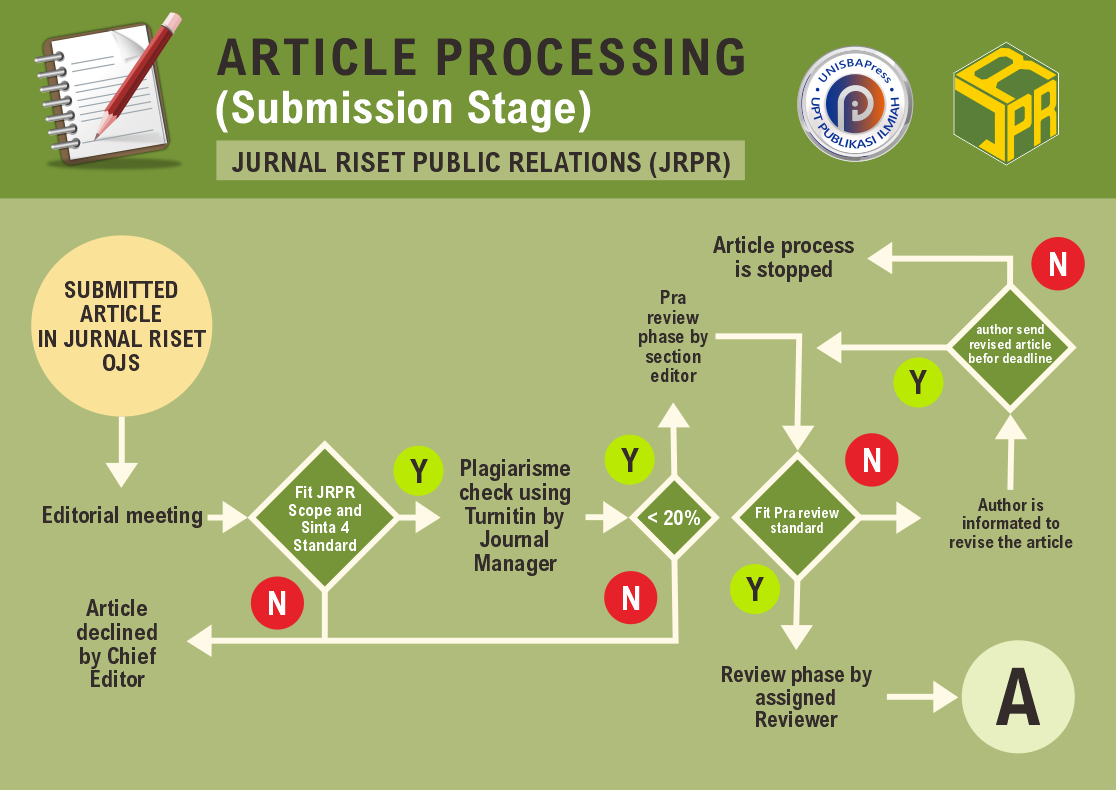Makna Hedonisme Melalui Fashion
DOI:
https://doi.org/10.29313/jrpr.v4i2.5475Keywords:
Gaya Berbusana, Hedonisme, KonsumtifAbstract
Abstrak. Mahasiswa Fakultas Kedokteran UNISBA, dalam konteks gaya berbusana dan perilaku konsumtif, memiliki dinamika kompleks di mana mereka mencoba untuk membangun dan mengungkapkan identitas sosial mereka melalui pilihan busana, merek, dan barang yang mereka kenakan. Berdasarkan fenomena tersebut peneliti bermaksud untuk mengetahui makna gaya berbusana dalam konteks hedonisme bagi Mahasiswa Fakultas Kedokteran UNISBA. Penelitian ini menggunakan metode kualitatif dengan pendekatan fenomenologi, serta teknik pengumpulan data yang dilakukan dengan observasi, wawancara dan dokumentasi. Hasil penelitian ini adalah tedapat tiga pandangan mengenai gaya berbusana sebagai ekspresi identitas dan kebebasan individual, sebagai representasi kelompok, dan sebagai norma lingkungan. Kemudian terdapar empat tipikasi penggunaan barang branded di kalangan mahasiswa Fakultas Kedokteran, yaitu status sosial, citra diri, sosial-branded, dan kebanggaan.
Abstract. Students of the Faculty of Medicine of the Islamic University of Bandung, in the context of fashion style and consumptive behavior, have complex dynamics in which they try to build and express their social identity through the choice of clothing, brands, and goods they wear. Based on this phenomenon, the researcher intends to find out the meaning of fashion style in the context of hedonism for UNISBA Faculty of Medicine students. This research used a qualitative method with a phenomenological approach, and data collection techniques were carried out by observation, interview and documentation. The results of this study are three views of the style of dress as an expression of individual identity and freedom, as a group representation, and as an environmental norm. Then there are four typifications of the use of branded goods among Faculty of Medicine students, namely social status, self-image, social branded, and pride.
References
Ahmadi, D. (2008). Interaksi Simbolik:Suatu Pengantar. Jurnal Mediator, 9(2).
Ahmadi, D. (2011). Pemaknaan Hakikat Diri Akuntan Publik. In MIMBAR: Vol. XXVII (Issue 2).
Ahmadi, D., & Yohana, N. (2007). Konstruksi Jilbab sebagai Simbol Keislaman. MediaTor: Jurnal Komunikasi, 8(2), 235–248.
Anggraini, R. T., & Santhoso, F. H. (2019). Hubungan antara Gaya Hidup Hedonis dengan Perilaku Konsumtif pada Remaja. Gadjah Mada Journal of Psychology (GamaJoP), 3(3), 131. https://doi.org/10.22146/gamajop.44104
Corrylia Almira Rahma Raissa, & Ahmadi, D. (2022). Kegiatan Media Relations Dalam Mempertahankan Citra Positif. Jurnal Riset Public Relations, 59–66. https://doi.org/10.29313/jrpr.vi.1087
Dewi, A. R., & Ahmadi, D. (2022). Hubungan Terpaan Tweet “Twitter, Please Do Your Magic” dengan Sikap Remaja. Jurnal Riset Public Relations, 6–13. https://doi.org/10.29313/jrpr.vi.639
Dewojati, C. (2021). Sastra Populer Indonesia . UGM PRESS. https://books.google.co.id/books?hl=en&lr=&id=AjcWEAAAQBAJ&oi=fnd&pg=PA1&dq=%5B2%5D%09Dewojati,+C.+(2021).+Sastra+Populer+Indonesia.+UGM+PRESS.&ots=A1U3bJFGyP&sig=Pcoj52EtwdnUtLqjjVXAnJL6yHY&redir_esc=y#v=onepage&q=%5B2%5D%09Dewojati%2C%20C.%20(2021).%20Sastra%20Populer%20Indonesia.%20UGM%20PRESS.&f=false
DJAYA, T. R. (2020). Makna Tradisi Tedhak Siten Pada Masyarakat Kendal: Sebuah Analisis Fenomenologis Alfred Schutz. JURNAL EKONOMI, SOSIAL & HUMANIORA, 1(06), 21–31. https://jurnalintelektiva.com/index.php/jurnal/article/view/65
Firnanda Listiyanti, D., & Ahmadi, D. (2022). Hubungaln alntalral Talyalngaln Alkun Tiktok @Liputaln6.Com dengaln Pemenuhaln Kebutuhaln Informalsi. Balndung Conference Series: Public Relaltions, 2(1), 325–332. https://doi.org/https://doi.org/10.29313/bcspr.v2i1.1246
Iskandar, D. (2015). Studi Fenomenologi Motif Anggota Satuan Resimen Mahasiswa 804 Universitas Negeri Surabaya. 3(1).
Kurniawati, R., Andriani, D. N., & Daroin, A. D. (2022). Analisis perilaku konsumsi mahasiswa Universitas PGRI Madiun. SEMINAR NASIONAL SOSIAL, SAINS, PENDIDIKAN, HUMANIORA (SENASSDRA), 1(1), 429–439. https://prosiding.unipma.ac.id/index.php/SENASSDRA/article/view/2731
Machmud, M. (2011). Perkembangan Teknologi dalam Industri Media. Jurnal Teknik Industri, 12(1), 57–64. https://doi.org/10.22219/JTIUMM.Vol12.No1.57-64
Mufidah, T., & Ahmadi, D. (2023). Hubungan antara Iklim Komunikasi Organisasi dengan Motivasi Kerja Karyawan. Journal Perspectives in Communication, 1(1), 19–27. https://journal.sbpublisher.com/index.php/person
Putri, A., & Huda, N. (2018). Pengaruh Gaya Hidup, Sikap Uang, Nilai Pribadi, Stimulasi Pemasaran Terhadap Keputusan Pembelian Terhadap Smartphone Android (Studi Kasus Mahasiswa Muhammadiyah Stikes Banjarmasin). JWM (Jurnal Wawasan Manajemen), 6(1), 26–44. http://en.wikipedia.org/wiki/
Qorib, F., Utami Rezkiawaty Kamil, S., Jumrana, & La Tarifu. (2022). Reshaping Today’s Education with Social Media. Jurnal Riset Public Relations, 105–110. https://doi.org/10.29313/jrpr.vi.1355
Rahmi, S. (2021). Komunikasi interpersonal dan hubungannya dalam konseling. Syiah Kuala University Press.
Sakinah, N., & Nanda, M. (2022). Trend Fashion di Kalangan Mahasiswa-Mahasiswi Universitas Negeri Surabaya. Prosiding Seminar Nasional Ilmu Ilmu Sosial (SNIIS), 2022, 32–38.
Sari, N. (2018). Hubungan Antara Gaya Hidup Hedonis Dan Perilaku Konsumtif Dengan Perilaku Melanggar Peraturan Etika Berbusana Mahasiswa Pendidikan IPS FIS UNY. Social Studies, 3(3), 534–546.
Setiadi, N. J. (2019). Perspektif Kontemporer Pada Motif, Tujuan, Dan Keinginan Konsumen (3rd ed., Vol. 3). PrenadaMedia Group.
Sulaiman, A. I., & Ahmadi, D. (2020). Empowerment communication in an islamic boarding school as a medium of harmonization. Jurnal Komunikasi: Malaysian Journal of Communication, 36(4), 323–338. https://doi.org/10.17576/JKMJC-2020-3604-20
Supraja, M., & Al Akbar, N. (2021). Alfred Schutz: Pengarusutamaan Fenomenologi dalam Tradisi Ilmu Sosial. UGM Press.
Syadzwina, A. W. W. at al. (2014). Fenomenologi perilaku komunikasi suporter fanatik sepakbola dalam memberikan dukungan pada psm makassar. Jurnal Komunikasi KAREBA, 3(1), 1–7.
Tampongangoy, A. (2022). Globalisasi dan perubahan sosial. https://doi.org/10.31219/osf.io/92yfg
Tertia, H., & Palapah, M. A. O. (2021). Komunikasi Interpersonal untuk Menumbuhkan Kepercayaan Diri Korban Catcalling.
Zuhriyah, D. (2020). Perilaku Konsumtif ditinjau dari Gaya Hidup Hedonis dan Persepsi terhadap Iklan Produk Wardah pada Mahasiswi UIN Raden Intan Lampung. UIN Raden Intan Lampung.















